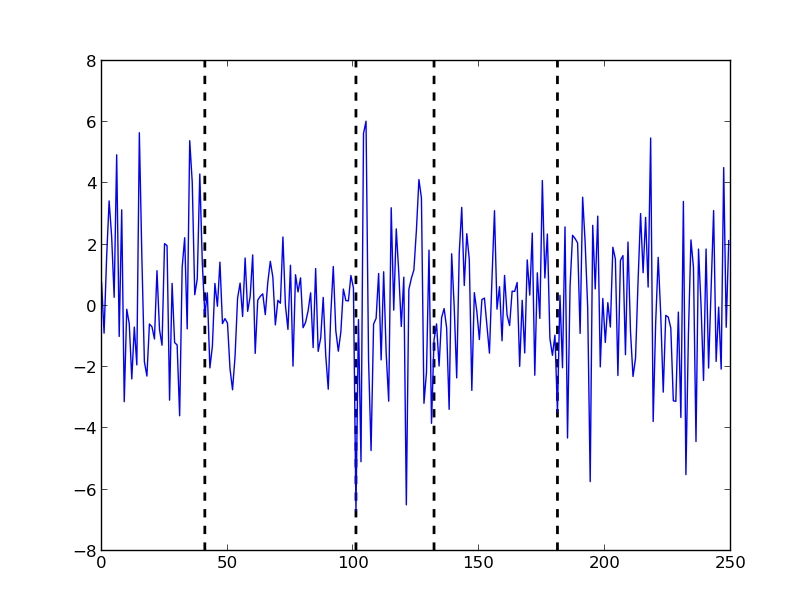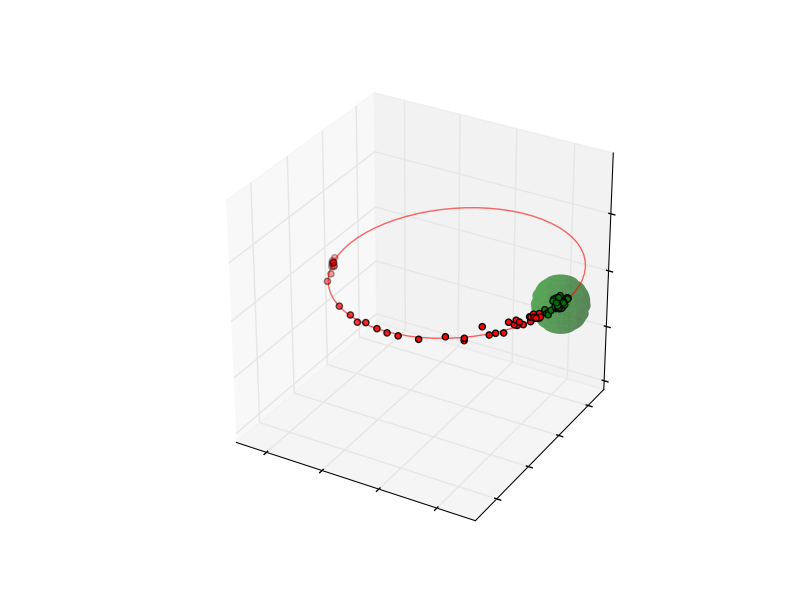Contents
Overview
This package provides a ROS service that implements CHAMP, an online Bayesian changepoint detection algorithm. Given a set of parameterized models, CHAMP can detect changepoints in time series data, in which the underlying model generating the data appears to change. CHAMP can detect changes between different models, as well as changes in generative parameters within a given model class.
Several model types come standard with the package (1D Gaussian, articulation models), and more can be added easily through a pluginlib interface. When adding additional models, essentially all that is required is a likelihood / BIC function for the model, and a way of fitting model parameters to a given segment of data.
This tech report describes the technical aspects of CHAMP in detail.
Installation
Currently, this package must be installed from source and also requires the articulation package to build the articulation plugin. Both are easy to build using rosmake:
1 svn co http://alufr-ros-pkg.googlecode.com/svn/trunk/articulation
2 git clone https://github.com/sniekum/changepoint.git
3 cd changepoint
4 rosmake
Parameters
There are only 5 parameters of CHAMP that must be set:
- len_mean: The expected mean length of segments.
- len_sigma: The expected variance of segment length. Make this large if little is known about the length of segments.
- min_seg_len: The minimum length of any segment. This is generally dictated by model class (i.e. 3 points needed to fit a plane). This can also be set higher to prevent overfitting.
- max_particles: The maximum number of particles in the particle filter used to keep track of the distribution over the location of the most recent changepoint. More particles results in better results, but slower performance.
- resamp_particles: The number of particles to resample down to after max_particles have been exceeded. Usually this will be equal to max_particles, but there is evidence in the literature that having it be significantly less than max_particles can be useful, because the resampling decision can be made jointly once every few time steps, rather than incrementally at every time step.
NOTE: Currently, the DetectChangepoints ROS service only supports detection on batch data, despite the algorithm being online. Future updates will expose an interface that allows online usage.
Example 1: Gaussian 1-D model
This first example uses a single model, in which data is generated from a zero-mean Gaussian, but where the variance of the distribution can change between segments. Simulated data is provided in the test/data folder that contains 5 segments of Gaussian data with changing variance.
First, run the changepoint server:
1 roslaunch changepoint changepoint_server.launch
Then:
should result in: 
Model: Gaussian Length: 41 Start: 0 End: 40 mu : 0.0 sigma : 2.38037437793 log_likelihood : -93.7340487169 model_evidence : -97.4476207836 Model: Gaussian Length: 60 Start: 41 End: 100 mu : 0.0 sigma : 1.11776428109 log_likelihood : -91.8161427535 model_evidence : -95.9104873158 Model: Gaussian Length: 31 Start: 101 End: 131 mu : 0.0 sigma : 3.18557109903 log_likelihood : -79.9046735685 model_evidence : -83.338660773 Model: Gaussian Length: 49 Start: 132 End: 180 mu : 0.0 sigma : 1.58176429671 log_likelihood : -91.9964906366 model_evidence : -95.8883109347 Model: Gaussian Length: 69 Start: 181 End: 249 mu : 0.0 sigma : 2.39939035641 log_likelihood : -158.296572189 model_evidence : -162.530678693
Example 2: Articulation models
This second example uses 3 separate models of articulated motion from the articulation package: rigid, prismatic, and revolute. This comes from work described in:
J. Sturm, C. Stachniss, and W. Burgard. A probabilistic framework for learning kinematic models of articulated objects. Journal of Artificial Intelligence Research, 41(2):477–526, 2011.
Example data is provided in the test/data folder (in the form of a difference trajectory of the poses of two objects) that contains 2 segments: rotational motion, followed by rigid motion between two objects.
First, run the changepoint server:
1 roslaunch changepoint changepoint_server.launch
Then:
should result in: 
Model: rotational Length: 43 Start: 0 End: 42 rot_radius : 0.100188846698 rot_center.x : -0.0237696457762 rot_center.y : -0.0232395299195 rot_center.z : -0.00476561153689 rot_axis.x : 0.0168210955552 rot_axis.y : -0.0347638765967 rot_axis.z : 0.240095357072 rot_axis.w : 0.969980795243 rot_orientation.x : -0.000544986444002 rot_orientation.y : -0.0180811333546 rot_orientation.z : 0.133017461034 rot_orientation.w : 0.990948601425 log_likelihood : 185.088191002 model_evidence : 6.43118550699 Model: rigid Length: 63 Start: 43 End: 105 rigid_position.x : 0.0763430434138 rigid_position.y : -0.0408163083626 rigid_position.z : 0.00269622400637 rigid_orientation.x : 0.0437177485907 rigid_orientation.y : -0.019221237714 rigid_orientation.z : 0.0095507242092 rigid_orientation.w : 0.998813338991 log_likelihood : 258.428841159 model_evidence : 245.99943698
Unlike the Gaussian example, the articulation models have some parameters to tune. Currently, these are hardcoded in articulation.cpp. A brief description of each:
- sigma_position: The expected standard deviation of position data in meters. It is very important for this to be approximately accurate based on the noise of the source of your data, as it greatly affects how heavily to penalize deviations from a model, which in turn distinguish between actual change and noise.
- sigma_orientation: The expected standard deviation of orientation data in radians. Also important to set correctly for the same reasons as sigma_position.
- optimizer_iterations: The number of iterations to run nonlinear BFGS optimization on each set of parameters from each SAC iteration. Even if this is set to 0, there will still be optimization done on the final parameters. It is generally fine to set this to 0, and setting it higher than zero will greatly impact running time.
- sac_iterations: The number of sample consensus (SAC) iterations to randomly try to find good model parameters for each segment fit.
- prior_outlier_ratio: The expected weighted outlier ratio from Sturm et al.







